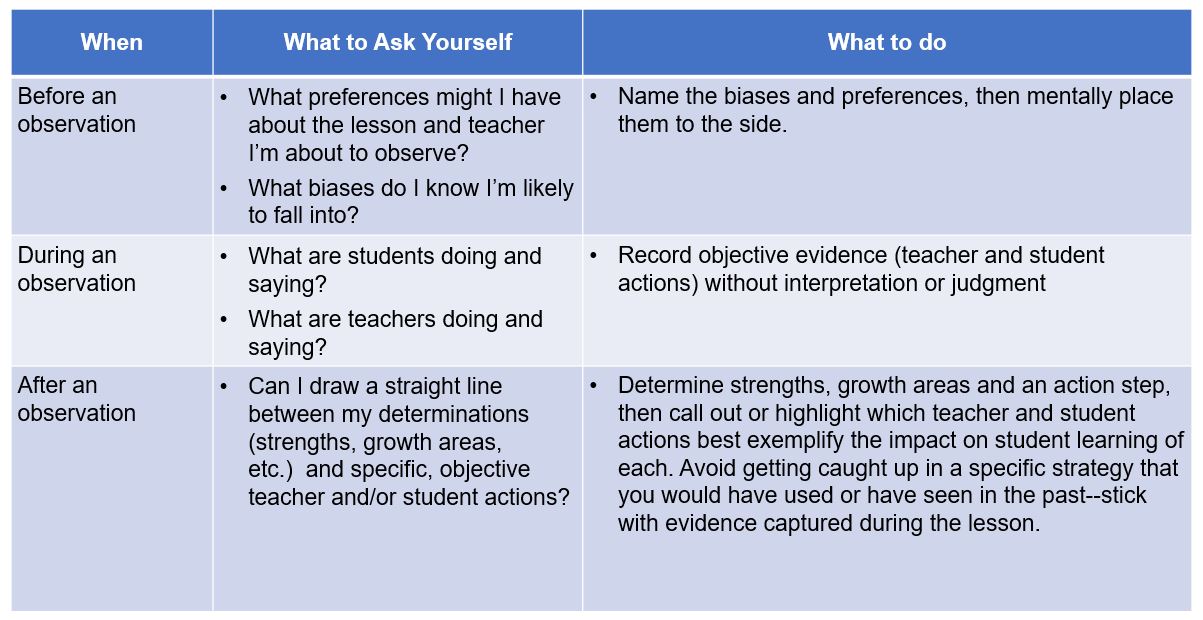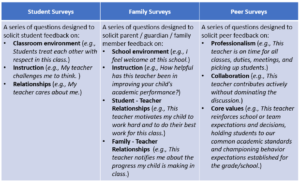Posts Tagged ‘Leaders’
Three Steps to Avoid Common Observation Biases
We all have biases. Whether picking an ice cream flavor or choosing to take the scenic route rather than the highway, we all operate with mental models that place disproportionate weight on certain factors that move our judgment in favor of one option when compared to another.
When observing and evaluating teacher practice, there are numerous opportunities for biases to creep in. Just think of all the factors that go into a lesson: the subject, grade, school, teacher, time of day, lesson structure, materials used and more. An observer may think to themselves, “the students were well-behaved for the first class right after lunch”. A different person observing that same lesson may think, “if I was teaching this class, I would have used a different text.” Both of these sentiments may be true, but they have to be placed aside before conducting a visit so that observers can focus on objective teacher and student actions.
In short, great observers, coaches, and evaluators must identify, then set aside, biases in order to fairly and accurately evaluate and develop teacher practice.
Common biases include:
- Confirmation bias: the tendency to search for or interpret information in a way that confirms one’s preconceptions,
- Halo effect: the tendency for a person’s positive or negative traits to “spill over” from one area of their personality to another in others’ perceptions of them, and
- Mirror bias: the tendency to judge performance as “good” if it is “like I would have done it.
A full table of common observer biases with examples can be found here: Observer Bias Examples
In order to mitigate the impact of these biases, great observers should ask themselves three questions:

Round 3: Looking Back, Looking Ahead
In our previous two posts (here and here), Sarah and Grant shared reflections on the past year and projects they are looking forward to in the coming months. To bring us home, Jessica shares lessons learned on working through complexity and opportunities to lead with appreciation.
What I learned: I have spent most of my career in education supporting and working in large bureaucracies, namely large urban districts and state education agencies. Just prior to joining Hendy Avenue I was in senior leadership in one of the largest school districts in Ohio. Each of the organizations I’ve worked with in the past have faced challenges, and I tended to chalk those up to organizational complexity, and the difficulty that comes with arriving at solutions when you must invest a large number of people and perspectives in the strategies. After spending my first year with Hendy working with diverse organizations and districts, I came to appreciate that the challenges I faced in past contexts are not so different from those faced by clients of all sizes. I’ve learned that it’s often not only the scale and bureaucracy that causes the challenges we face in K-12 education, and that we can learn a lot from organizations of different sizes and types in finding solutions. As we partner with our clients this year, we are excited to continue to bring lessons learned from all shapes and sizes of districts, states, schools and networks to arrive at solutions to problems.
What I’m excited about: I am so happy to get to continue to partner with Independence Mission Schools in Philadelphia. Having attended Catholic schools as a child, I have a great appreciation and admiration for the work IMS is doing for some of Philadelphia’s most deserving students. We learned a lot from IMS’ leaders and teachers as we supported them last fall to implement their new instructional framework, and to modify that framework to fit their Catholic culture. Now, I’m excited to continue to support IMS leaders as they deeply invest in teachers through teacher leadership. This project has been a welcome opportunity to explore how others are solving a problem, learn more about the context, strengths and opportunities in IMS schools, and devise a program that makes a difference for teachers, and students, across the network.
Keeping the Right People on the Bus
We all know the importance of getting the right people on the bus. But how do we KEEP the right people on the bus?
For all students to thrive, nothing is more important than great teachers and leaders. Yet, we know that recruiting, developing and retaining excellent educators is hard. In eagerness to do better, strategies for teacher and leader retention are often implemented without a thorough examination of the root causes.
To address this challenge, we are now offering an Annual Retention Review to help school system leaders understand why teachers and leaders are leaving and what can be done about it.
We know this work is important, but often falls to the bottom of the to-do list. Through exit surveys and individual interviews of non-returning teachers and leaders, we will develop actionable recommendations to drive your talent strategy. With 25 years of combined experience in developing and leading educator retention solutions, we have the expertise and capacity to help you assess and plan strategies to keep the right people on the bus.
To learn more, email Sarahrosskamm@hendyavenue.com.
Put Excellence at the Heart of Performance Management
Performance management, at its core, sets expectations. It puts a stake in the ground for what “good” looks and sounds like in the classroom and serves as the baseline of teacher observation rubrics. Effective performance management is more than diagnosing current performance; it supports teachers to articulate an actionable, clear trajectory toward excellence. Ultimately, a vision of good teaching and learning must be at the heart of any performance management system.
Common Pitfall: Framework Without Vision
Too often schools and districts launch a performance management system by creating or selecting a rubric without consideration of core instructional priorities. Enthusiasm and urgency, while helpful, can lead to less than ideal system design.
For example, simply adopting an existing framework because it is “proven” or “research-based” might not actually lead schools and teachers to excellence: what might be excellent teaching in one context might not be true in another setting. Creating a framework from scratch in a vacuum, separate from instructional priorities, isn’t likely to lead teachers to excellence either.
This doesn’t mean that adopting an existing framework is the wrong strategy, or that creating something new won’t get leaders and teachers where they need to be. It does mean, though, that this work must be grounded in the core realities of instruction necessary to move kids.
Ground Performance Management in a Vision for Excellent Instruction
Co-design and co-own by instructional leaders. Defining excellence for as complex a role as teaching requires a team of individuals, with different areas of expertise and focus. While very often, the development of teacher evaluation systems lives within talent/human resources, great systems strategically draw in additional stakeholders. For quality operations, a talent leader should drive and own the design and implementation of a performance management framework. At the same time, this work should be a shared priority between leaders of talent, academics and school management functions in a network or district. Instructional leaders working in schools daily must be the core authors and implementers of expectations for teachers.
Measure what matters. If teachers are held to expectations through a framework that aligns with core instructional priorities, schools are more likely to see improvement in the areas that matter most for students. If a solid instructional vision grounds all decision making, then curricular resources, training, and other supports will naturally stem from that vision. As teachers are supported to meet expectations via appropriate the resources, materials, and training, student learning will flourish.
Lead from your vision. Consider the following questions, and strategically engage others to ensure answers reflect the perspectives of a broad range of stakeholders:
- What are our prevailing beliefs within our system about students, and the role teachers play in their success?
- What do the instructional standards require from our students? And then, by extension, from our teachers?
- In classrooms where good teaching and learning is happening, what are teachers doing? What are students doing?
- How does this differ for different students? Different contexts?
- How do we ensure that the performance management system we design reflects our vision of excellent teaching?
- Who will own this work? How will we ensure that leaders from talent and instruction both continue to be involved?
Let us know what you think in the comments below!
-Jessica
Designing Evaluation Frameworks with Development at the Core – Part III: Amplifying Stakeholder Voice with Surveys
This post is the third in a series on how innovators are reimagining the design and implementation of evaluation and development frameworks. Read our earlier posts on observation frequency and raising rubric rigor.
When you think of a teacher, where are they? What are they doing? If you envisioned someone standing in front of a blackboard, lecturing a group of students, you’re likely not alone. In reality however, teachers spend their days in a multitude of ways: working individually with students, collaborating with peers, planning independently, connecting with parents and family members.
Definitions of excellent teaching therefore must go beyond classroom observations and measures of student outcomes (both of which are important!), to gather a broader view of a teacher’s impact.
Surveys are a simple, yet powerful tool that can amplify the voices of stakeholders from across a school community to help educators develop a comprehensive view of excellence.
The Benefits of Administering Surveys
- Surveys, coupled with other measures like classroom observations, provide rich information to help teachers improve their practice. Teaching is a complex job that depends on strong relationships. While districts and schools have made progress in collecting data and providing feedback on certain aspects of the profession (e.g., content knowledge, teaching strategies, assessment data), our field often misses the opportunity to coach teachers on their relationship building with students, families and peers.
- Research says that students are reliable evaluators of a teacher’s impact. Analysis by the Measures of Effective Teaching (MET) project finds that teachers’ student survey results are predictive of student achievement gains. In other words, students know an effective classroom when they experience one.
- Surveys provide the opportunity to put values into practice. Value statements like “we are a team and family” or “parents are partners” are powerful; however, these beliefs are only as true as the actions taken to build an authentic community. Administering surveys of key stakeholders sends a strong message that the voices of community members are valued, respected and heard.
- Surveys provide clear and transparent expectations to teachers. When questions are shared with teachers in advance, the survey content provides clear definitions for expected behaviors in teacher-to-teacher, teacher-to-student, and teacher-to-family relationships. For example, if a survey asks families if they receive one or more positive phone calls a month from their child’s teacher, that sets a very clear expectations for the teacher-family relationship.
Survey Types
Educators have available a number of survey types, structures, question formats and administration platforms.The table below highlights three common survey types.
Surveys should be designed thoughtfully, taking into consideration the purpose, audience, and respondents.
- Purpose – Why are you administering the survey? What do you hope to learn? How will results be utilized?
- Audience – Who will analyze and interpret the survey results? When and how will they reflect on and plan from the results? How will the results be debriefed with teachers to improve practice?
- Respondents – Who will complete the survey? When and how will they complete the survey? What directions, supports and technology will be necessary for administration?

To learn more, including a list of sample survey questions, visit the resources page of our website.
5 Strategies for Scaling Effective Coaching
Our team spends a lot of time thinking about how to develop teachers. We believe that investing in the professional growth of teachers has the potential to dramatically change the landscape of education in our country and the lives of millions of children. While school systems across the U.S. spend billions of dollars annually on teacher professional learning and development we have little proof of their efficacy (The Mirage, TNTP 2015).
Given this context, we were thrilled to read a new study, The Effect of Teacher Coaching on Instruction and Achievement by Matthew Kraft and Dylan Hogan of Brown University and David Blazar from Harvard University. Kraft and his team conducted a meta-analysis of 37 studies and found coaching programs to positively impact instruction (.57 standard deviations) and student achievement (.11 standard deviations). The authors offer the following summary:
The results of our meta-analysis suggest that teacher coaching programs hold real promise for improving teachers’ instructional practice and, in turn, students’ academic achievement. These findings provide strong motivation to invest in efforts to scale up teacher coaching models, and to expand and improve upon the existing research base.
Effective Coaching
The authors characterize the coaching process as one where instructional experts work with teachers to discuss classroom practice in a way that is:
- Individualized: one-on-one sessions
- Intensive: frequent interaction between teachers and coaches (e.g., at least every couple of weeks)
- Sustained: coaching support over an extended period of time
- Context-specific: coaching on their practices within the context of a teacher’s classroom
- Focused: teachers and coaches engage in deliberate practice of specific skills
These findings support much of the work we have done with school systems including KIPP Austin Public Schools, DREAM Charter School and the Cleveland Metropolitan School District to grow talent through multiple-measure evaluation and development frameworks. Each of these organizations have employed innovations specific to their unique contexts, however common across all approaches is a theory of change that recognizes the critical role coaches play in moving teacher practice and ultimately student outcomes.
Scaling Systems of Effective Coaching
One of the most important insights in the analysis is data suggesting “that coaching can have an impact at scale” but that scaling-up programs (to more than 100 teachers) is challenging, particularly in building a cohort of capable coaches and in establishing strong teacher buy-in.
From our experience, these two factors matter mightily. There are certainly pockets of excellent coaching in every school system, but the real challenge of scale is consistency of implementation. Here are five strategies for solving the scale-up challenges described by Kraft, Blazar and Hogan:
1. Establish a common definition of excellence: Coaching is incredibly hard work as it requires deep content knowledge, pedagogical expertise, emotional intelligence and strong interpersonal communication skills. One the best steps we can take to set coaches up for success is adoption of a clear definition of excellent teaching (e.g., a robust rubric or vision of excellence document). In establishing a common bar of quality of important instructional practices and a common language, coaches and teachers have a clear development road-map to work along. You can read more about strong observation rubrics in this March 2017 post.
2. Make Tools Available: Great coaches need tools to guide their learning and development. School systems should develop and train leaders on a common observation debrief protocol or conversation guide such as Paul Bambrick’s 6-Steps to Effective Feedback or the TEF Debrief Planning Guide to structure coaching conversations. Systems for capturing, analyzing and sharing observation data including observation ratings and feedback are also vital for supporting coaching efforts.
3. Invest in ongoing leader development: Often lost in conversations around teacher professional development is the importance of ensuring professional learning for those responsible for coaching teachers. These professionals warrant the same level of thoughtful support. Summer is a great time to bring coaches together for intensive training but without ongoing follow-up, development can be lost or minimized. Managers of coaches should have talent development within their core responsibilities including time for managers to observe and support school leaders/coaches working with their teachers.
4. Build a Culture of Transparency and Continuous Improvement: Ultimately the work leaders do coaching teachers is only as impactful as the level of trust and partnership teachers feel in the relationship. Transparent communication of the “why” and “how” of key policies along with timelines, goals, and progress to-date is essential for successful long-term investment. Gathering frequent feedback with public recognition of the findings and appropriate next steps will build a culture of continuous improvement.
5. Phase-in implementation: As noted in the study, working one-on-one with any person over a sustained period requires an investment of time and money. Certainly shifting funds from less effective professional development activities toward coaching is a strong first step. Another strategy is to phase-in implementation of a coaching program to build capacity, gain early wins, expand the coalition of supporters, and prove the value of the financial investment. We suggest system leaders identify the core problem they are hoping to solve, then target the first phase of implementation toward that issue. For example, if a system seeks to solve the challenges that arise from new teachers lacking foundational classroom management skills they can launch a coaching program focusing on that subset of teachers. Over time, coaches could roll-off and target other groups of teachers for support or the program could expand with the hiring of additional coaches.
What approaches to coaching teachers have you seen work well? How have you built a cohort of strong coaches and/or invested teachers? Let us know in the comments below!
Great Leaders, Great Teachers: How Cleveland Metro is Investing in Leaders
In response to Race to the Top, many states, including Ohio, revised state statutes requiring school districts to develop new evaluation models. In a collaborative effort, the Cleveland Metropolitan School District and the Cleveland Teachers’ Union developed the Teacher Development and Evaluation System (TDES).
We partnered with the talent team at CMSD to develop tools and trainings designed to enhance administrators’ ability to successfully evaluate and develop their teachers. We began the engagement with a robust review of existing research and best practices in order to establish a clear description of the knowledge and skills necessary for leading effective observation and feedback.
Following stakeholder review and investment in the new district-wide expectations, we established a theory of action for building administrator capacity across the district, developing an aligned scope and sequence of training modules aimed at achieving CMSD’s goals. Each training module focuses on both observer calibration and quality feedback for improvement, sharing tools and protocols aimed at bridging the learning into the daily practice of administrators.
Taken together, these training modules provided administrators regular opportunities to reflect on and hone their practice as instructional leaders, improving teacher quality and ultimately, the achievement of students across the district.







